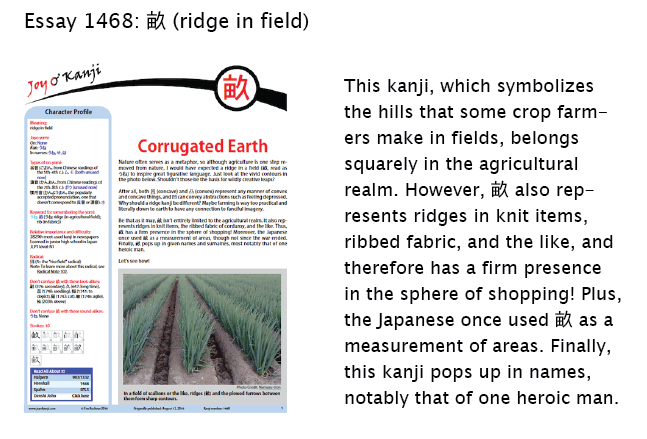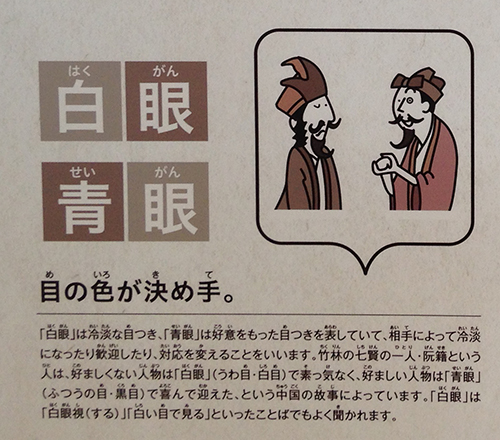A Return to the Kanji Museum
Did you know that 青眼, which breaks down as blue + eyes, is the standard Asian eye color? And do you know what it means for someone to look at you with white eyes?
Last time, I blogged about some of the features at the brand-new kanji museum in Kyoto. This week I'd like to return there (in a virtual sense) to examine two more thought-provoking offerings, including the eye color issue. All photos are by Ulrike Narins.
1. The Question of てんてきうち
First up, we have this:
This is a sample sentence in which これから_____にいきます means "I'm now going to do _____." In the middle we find てんてきうち, which one could represent in two ways:
a. 点滴打ち b. 天敵討ち
Let's pretend that you're able to interact with the touchscreen that museumgoers can actually use:
Which green "button" would you press?
I'll block the answer with a preview of the newest essay:

The answer is a. 点滴打ち. However, that alone doesn't clear things up because, as essay 1626 on 滴 (drop (of liquid), dripping) notes, 点滴 can have two very different meanings:
点滴 (てんてき: (1) intravenous drip; IV; (2) raindrop; falling drop of water) to put + drip
People almost always use this word in the first sense:
私は病院で点滴を受けた。
I had an IV in the hospital.
私 (わたし: I); 病院 (びょういん: hospital);
受ける (うける: to undergo)
And that's indeed the case in the museum quiz question; it's about an IV drip at a hospital, not raindrops as they strike (打つ) a roof or something. In conjunction with 点滴, the 打ち means "shooting" an IV drip.
As for the false answer, that breaks down this way:
天敵 (てんてき: natural enemy)
討つ (うつ: to defeat, destroy)
Obviously, it's not a good fit.
2. 白眼青眼
Next up we have this part of a museum display:
Here are the two largest words:
白眼 (はくがん) white + eyes
青眼 (せいがん) blue + eyes
Each is just a metaphor, not an actual eye color. These terms refer to the way someone looks at another person. Doing so with "white eyes" expresses coldness and indifference, whereas a "blue eye" look is warm and friendly.
As the small text in the image explains, the concept comes from ancient China, where a sage known as Ruan Ji (or as Genseki in Japan) would look at a person differently, depending on how he felt about that person. Don't we all do that? Well, not so much in Japan; though the museum text doesn't mention this part, the Japanese are supposed to hide their feelings, according to the concept of 建て前 (たてまえ: public position or attitude (as opposed to private thoughts)).
The museum text does say that this 青眼 means "black eyes," referring to pupils or "the ordinary look of the eyes." Perhaps 青 once had a broader meaning than it does today.
The text also indicates that the sage showed only the whites of his eyes to those he didn’t like. Technically, it says that his eyes were turned upward, which must have made it so that just the whites of his eyes were visible.
Instead of 白眼, the Japanese tend to use this expression:
白い目で見る
to look at with white eyes
白い (しろい: white); 目 (め: eye); 見る (みる: to look at)
People mostly put the verb in the passive voice:
白い目で見られる
to be looked at with white eyes
Here's an example:
サッカーの試合で失敗をしたので、彼は他の選手から白い目で見られた。
He made a huge mistake in the soccer match, so he got cold looks from his teammates.
試合 (しあい: match); 失敗 (しっぱい: mistake); 彼 (かれ: he); 他 (ほか: other); 選手 (せんしゅ: player)
My Japanese-language partner and I analyzed the small text of the sign in detail, and once I understood it, I was still puzzled by this word in the medium-sized title:
決め手 (きめて: (1) decider; person who decides; (2) deciding factor; clincher; trump card; winning move)
A decider? That brought back miserable memories of George W. Bush's presidency. But in this case, the idea is that someone's metaphorical eye (目, め) color (色, いろ) determines whether or not that person likes you.
With that (and Toni Morrison) in mind, I hope I only ever see the bluest eyes!




Comments